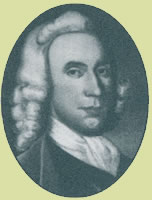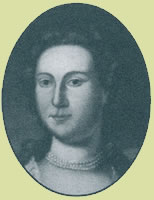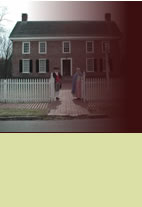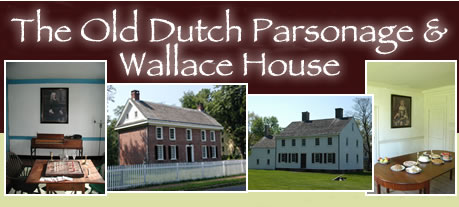While living at the Dutch Parsonage, the Reverend Mr. Jacob Hardenbergh sold 95 acres of land and a small farmhouse to John Wallace, a Philadelphia fabric importer and merchant. Between 1775 and 1776, Wallace purchased an additional 12 acres of land and built an eight-room Georgian style mansion adjoining part of the existing farmhouse. It was the largest house built in New Jersey during the Revolutionary
War. Naming his estate "Hope Farm," Wallace intended the property to be his country seat and place of retirement. Between 1775 and 1776, Wallace purchased an additional 12 acres of land and built an eight-room Georgian style mansion adjoining part of the existing farmhouse. It was the largest house built in New Jersey during the Revolutionary
War. Naming his estate "Hope Farm," Wallace intended the property to be his country seat and place of retirement.
In the winter of 1778, General George Washington's Continental Army encamped at Middlebrook in the Watchung Mountains, just 3 miles from Hope Farm. Washington chose the area because it was a defensible one, with a good network of roads, plenty of timber for the soldiers' huts, and a sympathetic populace.
The area had few houses, however, suitable for officers' quarters. Because John Wallace owned one of the largest homes in the area, he was asked to share his home with Washington and his staff. He agreed and the Wallace house became Washington's headquarters for that winter. After spending 11 days at his new headquarters, Washington left for Philadelphia to attend Congress for 6 weeks.
When he returned to the Wallace House in February 1779, his wife, Martha, aides and servants accompanied him. The General and his staff kept busy by hosting foreign dignitaries, preparing dinner
parties, and planning strategies for the upcoming spring military campaign. It was at the Wallace House that Washington and his staff planned the successful 1779 campaign  against the Iroquois League, fierce allies of the British. against the Iroquois League, fierce allies of the British.
Camp broke on June 3, 1779, and Washington, upon his departure, paid John
Wallace $1,000 for the use of his house and furniture.
Life returned to normal for the Wallace family. John Wallace occupied the house with his wife, Mary, his mother-in-law, Mary Maddox, his youngest son, William, and their slaves. Two older children, Joshua and Anne, lived nearby with their families.
In 1783, John Wallace and Mary Maddox died. Mary Wallace died the following year. William Wallace, at the age of 21, became the heir to Hope Farm. He lived there until his death in 1796 at age 33. His wife, Sarah had died before him and their three orphaned children went to live with their uncle, Joshua Wallace in Burlington, New Jersey. Joshua sold Hope Farm to Dickinson Miller in 1801, after the house
sat vacant for 5 years.
In 1896, after several families had
occupied the house, the Revolutionary
Memorial Society purchased the home
and used it as their headquarters
and museum.
In 1947, they gave the house to the State
of New Jersey. The Old Dutch Parsonage
and the Wallace House are both listed on
the New Jersey and National Registers of
Historic Places.
|




 Between 1775 and 1776, Wallace purchased an additional 12 acres of land and built an eight-room Georgian style mansion adjoining part of the existing farmhouse. It was the largest house built in New Jersey during the Revolutionary
War. Naming his estate "Hope Farm," Wallace intended the property to be his country seat and place of retirement.
Between 1775 and 1776, Wallace purchased an additional 12 acres of land and built an eight-room Georgian style mansion adjoining part of the existing farmhouse. It was the largest house built in New Jersey during the Revolutionary
War. Naming his estate "Hope Farm," Wallace intended the property to be his country seat and place of retirement.
 against the Iroquois
against the Iroquois